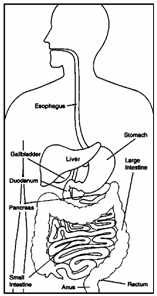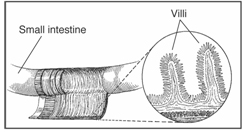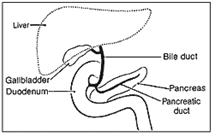Media Backgrounder
Quick Anatomy Lesson: Human Digestive System
The human digestive system, (also known as the digestive tract, the GI tract, the alimentary canal) is a series of connected organs leading from the mouth to the anus. The digestive system allows us to break down the food we eat to obtain energy and nourishment.
The digestive system -- which can be up to 30 feet in length in adults -- is usually divided into eight parts: the mouth, the esophagus, the stomach, the small intestine (or "small bowel") and the large intestine (also called "large bowel" or "colon") with the liver, pancreas, and gallbladder adding secretions to help digestion. These organs combine to perform six tasks: ingestion, secretion, propulsion, digestion, absorption, and defecation.

The mouth starts the process by ingesting and mechanically breaking down the food we eat into a swallowable form, adding some early secretions to start the process of digestion. The esophagus is the muscular tube connecting the mouth to the stomach. A ring-like muscle at the end of the esophagus controls the passage of food into the stomach. This ring-like muscle also controls the food from going back up into the esophagus. The stomach then further liquefies the food and adds digestive acids.

From there the stomach contents are slowly released into the small intestine. The small intestine is where most of the digestion and absorption of nutrients takes place. There are millions of tiny finger-like projections lining the small intestine called villi (pronounced: "VILL-ee"). These villi aid in the absorption of nutrients. Secretions from the liver, pancreas, and gallbladder are emptied into the small intestine and also aid in the digestive process.

After traveling through the nearly 20 feet of small intestine, unabsorbed material moves into the colon (large bowel or large intestine). Here the remaining liquids and salts (electrolytes) are absorbed from the digested material. Bacteria further break down the undigested material, which continues to solidify and eventually passes from the body as feces through the rectum and anus during a bowel movement.
Reviewed August 2014